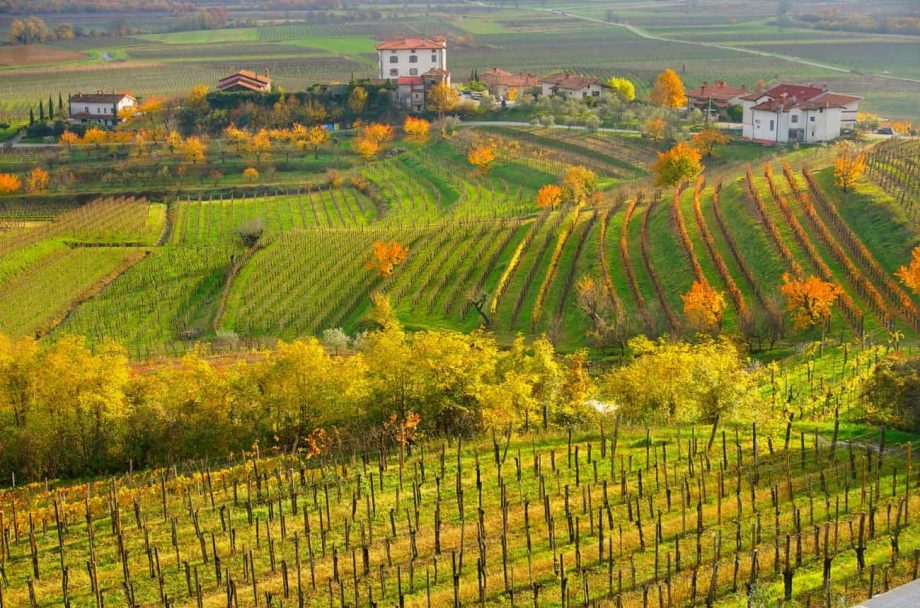Produced from the sun-kissed vineyards in Friuli Venezia Giulia, northeastern Italy, where the specific microclimate and the unique terroir to the Pinot Grigio grape.
Pinot Grigio is one of the most popular Italian wine styles and, while the grape shares the same genetic fingerprint with one of Alsace, France’s noble varieties, Pinot Gris, its different spelling and origination foreshadows unique styles of white wine. While Pinot Grigio has a distinctively Italian style, the grape hails from France, where it is called Pinot Gris, and is thought to have been introduced to Italy in the mid-19th century.

Eventually, the wine found success in the northeastern regions spanning Friuli-Venezia Giulia, Veneto and Trentino-Alto Adige.
When Pinot Grigio grapes are crushed and the skins are allowed to spend time with the juice, a teasing, tactile texture and coppery hue results in a distinct wine style called ramato. It comes from the word ‘rame’ which means ‘copper’ in Italian.
Rosé and orange wines can also exhibit colors that range from pale pink to salmon to deep amber, as a result of skin contact. But color alone cannot determine the wine style.
What distinguishes ramato from a rosé or orange wine is that ramato is a product of historical winemaking style from Friuli, Italy, made with Pinot Grigio grapes.
Rosés are made from a number of black grapes and orange wines are made from white grapes throughout the world.
How are Ramato wines made?
How does ramato gets its copper color from Pinot Grigio?
Pinot Grigio is not a white-skinned grape at all – its skins have a rosy-grey tone, hence the name ‘gris’ or grigio, meaning grey in French and Italian respectively. Pinot Gris/Grigio is a color mutation of Pinot Noir and the berries have a pinkish, if not entirely ‘grey’ appearance. Pinot Grigio is an easy-going conventional white wine with neutral flavors, and ramato is the copper-hued Italian farmhouse style.
Ramato’s copper-like luster is attributed to the extended maceration of the must on the skins during the winemaking process. This also adds to its unique flavors, aromas, structural complexity and tannic mass. But color also comes from the natural pigments of the grapes that seep into the juice while they are still on the vine.
Some producers use short maceration to achieve fresh and lighter wines, which often have a slight peach look. Others do longer maceration, which yields richer, autumnal shades.
2021 Sun Goddess Pinot Grigio Ramato
100% Pinot Grigio, Friuli DOC, Tauriano Estate, Spilimbergo (PN, Italy)
Gravelly soil, 393 ft altitude in the foothills of the Dolomite mountains, vineyards’ average age is 25 years old, dry, alcohol 12.5%, acidity 5.40 g/L
The nose is intense and complex, with hints of peach, melon, and blackberry. On the palate, it is round, with a subdued acidity, soft tannins, and a rich, minerally finish. If you’ve never had a ramato wine or skin-fermented white wine, it is an acquired taste because it does have a noticeable tannic component. It is very different than a typical white wine. I find that red wine drinkers tend to gravitate toward this style.
Vinification – short maceration (contact with the skins for a few hours at cold temperatures) followed by fermentation via natural yeast in temperature controlled stainless steel tanks at 64°F. The wine matures in stainless steel tanks for 4 months.
Because of the added textural component that the skin contact provides, ramato wines made from Pinot Grigio are very food friendly. Perfect as an appetizer wine before the start of the main course. It goes well with many hors d’oeuvres, charcuterie, soups and risottos. Not recommended to be sipped during or after dinner.
Cheers,
Michael


